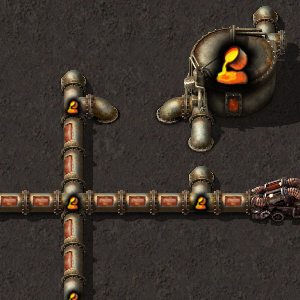Molten copper: Difference between revisions
No edit summary |
Copy the note about fluid wagons being more efficient than cargo wagons from Molten Iron page |
||
| (5 intermediate revisions by 2 users not shown) | |||
| Line 1: | Line 1: | ||
{{Languages}} | {{Languages}} | ||
{{:Infobox:Molten copper}} | {{:Infobox:Molten copper}} | ||
{{About/Space age}} | {{About/Space age}} | ||
'''Molten copper''' is the melted, liquid form of [[copper ore]] that has been smelted by a [[foundry]]. | '''Molten copper''' is the melted, liquid form of [[copper ore]] that has been smelted by a [[foundry]]. On [[Vulcanus]], molten copper can also be generated by processing [[lava]]. Both methods of generating molten copper require [[calcite]]. Molten copper cannot be placed into barrels, so it cannot be sent to other planets. | ||
Once generated, molten copper can be cast into copper plates, but it can also be cast directly into [[copper cable]]s or [[low density structure]]. The copper cable casting recipe is [[Foundry#Copper cables|always more efficient compared to casting plate]] and using an [[assembling machine]], but not as efficient as using the [[electromagnetic plant]] with [[productivity module]]s of sufficiently high quality. | |||
A [[fluid wagon]] of molten copper represents more copper plates than a single [[cargo wagon]] can store. Even without [[productivity module]]s, 50,000 molten copper represents 7500 copper plates, nearly twice the storage of a cargo wagon (4000 copper plates). Additionally, even with legendary [[quality]] [[productivity module 3]]s, the 2000 copper ore that fills up a single cargo wagon would only generate 50,000 molten copper, the exact size of a fluid wagon. So fluid wagons always at least as efficient per wagon as ore or plate. | |||
== Alternative recipes == | |||
{|class="wikitable" | |||
|- | |||
! Process !! Input !! Output !! Made in !! Required technology | |||
|- | |||
| {{icon|Molten copper from lava}} Molten copper from lava | |||
| {{icon|Time|16}} + {{icon|Lava|500}} + {{icon|Calcite|1}} | |||
| {{icon|Molten copper|250}} + {{icon|Stone|15}} | |||
| {{icon|Foundry|space-age=yes}} | |||
| {{icontech|Foundry (research)|}} [[Foundry (research)]] | |||
|- | |||
|} | |||
Note that the molten copper from lava recipe generates more [[stone]] than the [[molten iron from lava]] recipe. This makes copper a more [[calcite]]-efficient way to generate stone relative to copper. | |||
== History == | == History == | ||
{{history|2.0.7| | {{history|2.0.7| | ||
Latest revision as of 19:19, 9 August 2025
| Molten copper |
|
Recipe |
|
| ++ → | |
|
Total raw |
|
| ++ | |
|
Prototype type |
|
|
Internal name |
molten-copper |
|
Required technologies |
|
|
Produced by |
|
|
Consumed by |
|
![]() Space Age expansion exclusive feature.
Space Age expansion exclusive feature.
Molten copper is the melted, liquid form of copper ore that has been smelted by a foundry. On Vulcanus, molten copper can also be generated by processing lava. Both methods of generating molten copper require calcite. Molten copper cannot be placed into barrels, so it cannot be sent to other planets.
Once generated, molten copper can be cast into copper plates, but it can also be cast directly into copper cables or low density structure. The copper cable casting recipe is always more efficient compared to casting plate and using an assembling machine, but not as efficient as using the electromagnetic plant with productivity modules of sufficiently high quality.
A fluid wagon of molten copper represents more copper plates than a single cargo wagon can store. Even without productivity modules, 50,000 molten copper represents 7500 copper plates, nearly twice the storage of a cargo wagon (4000 copper plates). Additionally, even with legendary quality productivity module 3s, the 2000 copper ore that fills up a single cargo wagon would only generate 50,000 molten copper, the exact size of a fluid wagon. So fluid wagons always at least as efficient per wagon as ore or plate.
Alternative recipes
| Process | Input | Output | Made in | Required technology |
|---|---|---|---|---|
| Molten copper from lava | + + | + | Foundry (research) |
Note that the molten copper from lava recipe generates more stone than the molten iron from lava recipe. This makes copper a more calcite-efficient way to generate stone relative to copper.
